Literacy-Based Speech and Language Therapy Activities
$24.00
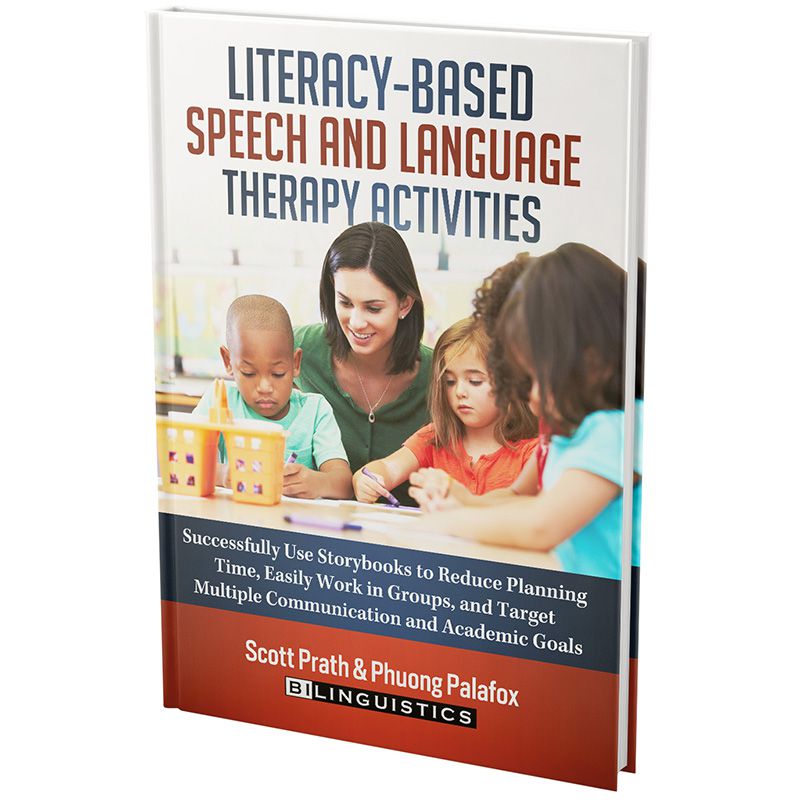
There has never been a faster, more fun, more effective way to engage children of all backgrounds while dramatically improving their communication. Now, you have all the research and resources in one book to learn how to make it a reality for you.
This book shows you how to successfully use storybooks to:
- Reduce Planning Time
- Easily Work in Large Groups
- Address and Incorporate Diversity
- Simultaneously Target Communication and Academic Goals
- Simultaneously Target Language and Speech Goals
Storybooks provide a platform to address academic needs and therapeutic goals and at the same time account for social and cultural factors. This book contains over 200 pages of templates, activity ideas, and materials you need to produce powerful intervention in no time! It has saved us oodles of time.
What’s Inside? Take a Look:
 The Gigantic Turnip (El nabo gigante) English-Spanish Bilingual Lit Kit free with this purchase.
The Gigantic Turnip (El nabo gigante) English-Spanish Bilingual Lit Kit free with this purchase.
$15.00 Free with this purchase.
We know you are busy and we know you want to get up and running with literacy-based intervention. That’s why we have included a free color version of the Gigantic Turnip Lit Kit so that you have instant therapy materials and can see how to adapt it to all of your own favorite storybooks.
12 reviews for Literacy-Based Speech and Language Therapy Activities
| Weight | 1.5 lbs |
|---|---|
| Dimensions | 11 × 8.5 × .5 in |
We all love using storybooks in intervention but the question is: How do we do use them effectively?
Literacy-Based Speech and Language Therapy Activities makes improving your therapy and reducing your planning time a reality. This 200-page book is full of templates, explanations, and examples for you to experience the same success we do with our busy, diverse caseloads.
Section 1 highlights The Research Behind Why Literacy-Based Intervention Works so well.
In Section 2 we learn how to decide if language difficulties are due to an impairment, second-language influence, or cultural difference.
After reading Section 3, you will be able to take any activity including your favorite storybook and design therapy that will last for several weeks. We provide pre-, during, and post-reading explanations and activities to assist in making your literacy-based intervention applicable to all age groups and disorder classes.
Taking data and measuring progress are some of the most difficult things to do well. In Section 4, we walk step-by-step through a child’s story to see what is present or missing, and how to write concrete, measurable goals.
Section 5 is 50 pages of easily reproducible templates to be used individually or in groups.
Lastly, in Section 6, we harness the power of high engagement and make Incredible Games that Match Story Content.
And a bonus! We end this book listing some of the best storybooks for intervention that are divided by age, grade, topic, and goals.
Need CEUs?

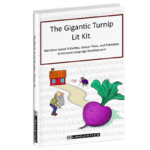 The Gigantic Turnip (El nabo gigante) English-Spanish Bilingual Lit Kit free with this purchase.
The Gigantic Turnip (El nabo gigante) English-Spanish Bilingual Lit Kit free with this purchase.





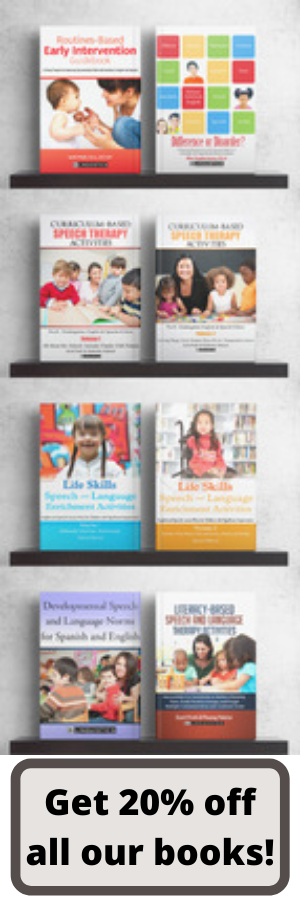
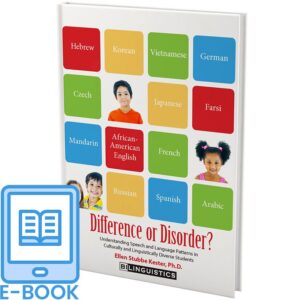
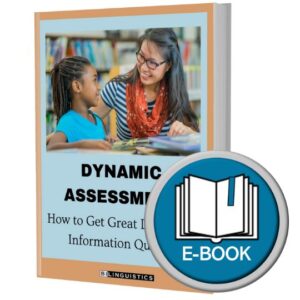
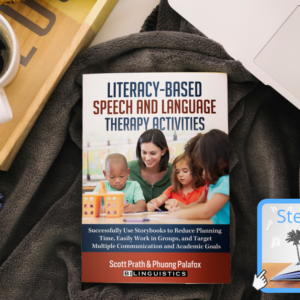
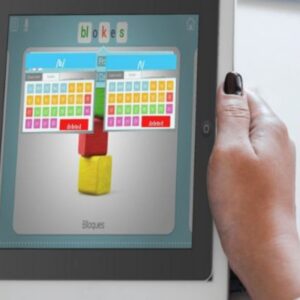
Jennifer O’Connor, MA, CCC-SLP –
I highly recommend this book for district Lead SLPs to purchase for their campus SLPs. Specifically, the story retell assessment framework the author’s explain is critical to functional goal writing. In addition, this resource provides an easy to read goal writing section. This section helps SLPs target goals that are directly related to the curriculum, giving our students the biggest impact to meeting their communication and education goals. I especially appreciate how the authors tie goal writing directly into IDEA and the Common Core (K-12). In addition, they include a detailed account of the TEKS (Texas Curriculum) that takes a deep look into goal writing by grade and communication domain (expressive/receptive language, articulation). This resource is a must for our students to achieve maximum progress in the educational setting.
phuonglienpalafox –
Jennifer, thank you, thank YOU, for the kind words. You got to the core of what we wanted to do with this resources. Books are so valuable, and they can support SLPs in so many meaningful ways. You have surely made an impact in our field, and we appreciate your sentiments.
Gina Glover –
Every SLP working with students should have this book. I can’t begin to cover all that is packed into the incredibly valuable resource. I’ve seen a lot of SLPs and their SLP-Assistants use books in therapy. However, I see too many read books and ask questions. That’s it. It’s a quick comprehension check and not therapy. This book teaches you how to use literature in therapy and provides details, examples, templates, etc., to do it successfully. There are lists of suggested books by grade level, templates in English and Spanish, story grammar visuals in English and Spanish and how to address articulation skills through literacy. My favorite aspect is the photos of actual work samples from real therapy sessions to help you see how to use these resources in your sessions.
Scott Prath –
Thank you Gina!
We debated long and hard about whether to include the template examples of the childrens’ work. It is hard to get a clear image of someone’s handwriting but we thought that actually seeing what therapy looks like is invaluable. The hands-on examples are always some of the best parts of our live presentations and we worked hard to try to convey it in text. I am happy that you found it valuable.
Best Regards, Scott
Julie Gruszynske M.A. CCC-SLP –
This is a great resource to streamline therapy planning and increase carry-over of skills into the general education curriculum. The examples and visual supports in the book mean I can pick this up and immediately implement the strategies and activities with my school aged clients. The list of actual storybooks is a great resource to help a clinician get started. I love how this resource is organized to support actual work with students, but includes all the information needed to prove that it’s truly evidence based practice.
Jennyfer Lancheros –
I highly recommend this book for any setting. If you are at a school, this book targets goals that are directly related to the curriculum. At a clinic, you can come up with a variety of therapy ideas based off one book (suggested in Appendix I) and if you are at home health setting parents will be able to understand better how literacy based intervention works. This book teaches you how to use a single book for MULTIPLE sessions. Often, I used to read a book and ask questions all in a 30 or so minute session. After using strategies in this book, I saw the importance of Pre-Reading and Post-Reading activities. I especially appreciate the templates provided in this book, it has given me a great starting point with Literacy-Based intervention and reduced my planning time.
Elizabeth –
As a new CFY, this has saved me so much time in lesson planning. I currently work in the home health setting, but have utilized this book so much already. The book is well organized, provides rationale for literacy based activities (aka research and statistics to implement evidence based practice), but best of all, provides templates that are ready to use as well as great list of books to use. The only thing to remember is that this book is geared toward Spanish/English kiddos, but as I work in a bilingual setting, it is ideal as finding Spanish materials can be hard to find. Highly recommend and will be continuing to use this throughout my career.
Scott Prath –
Thank you for this review and we are glad that the templates help out with diverse students! There are two versions of each template in the book – Spanish & English so that can we can choose the template that is best for our monolingual and bilingual kids. Hope to have more language templates on the website in the future.
Meagan Morgan –
As someone who has been doing literacy-based therapy for years, I appreciate how much of a time saver this book is. The free downloads, ready-made templates and lessons, reproducibles, and graphic organizers are bilingual and AMAZING.It is refreshing to read a book that puts research into practice and still keeps in mind the real-life struggles of managing a large, heterogeneous caseload. There are so many practical activities that I can use now without a lot of prep and they even include modifications for meeting the needs of special populations so that the activities can be used with everyone on my caseload. I loved the anecdotes, fun language, and visually-friendly formatting used throughout this book. It was a quick and easy read with resources that I will use for years to come!
Kara Sanchez –
This is an incredible resource for a speech therapist. I love the content and organization. This book makes it is easy to plan and organize multiple group therapy session for children with diverse needs. Exactly what an SLP needs who works with a high caseload. This book is thorough, entertaining and motivating when planning your sessions!
Tiffany Barker –
This thoughtfully organized resource is loaded with curriculum-based interventions that can be implemented in fun and interactive therapy settings. There are so many templates included in both Spanish and English with useful explanations of how to actually use them. In addition, they’ve included tips for writing curriculum-aligned objectives, lists of books by age, grade and topic, ways to create literacy-based games, and so much more. It’s a must for both new and experienced therapists alike and I will definitely be purchasing this for staff in the future.
Martha U –
I highly recommend this comprehensive resource to all SLPs. It is written in a very straight forward format, easy to follow and utilize the various resources found U inside. My favorites were definitely the visuals, book suggestions for targeting specific goals in the various areas of speech and language. The data collection ideas were also extremely helpful and easy to implement. Great addition to my therapy toolkit!
Maida Bermudez –
I just wanted to share with everyone my success with the resources in this book. I have just started using the strategies and recommendations for the past two weeks. My kiddos have made amazing drawings while just introducing the topic of the book I chose and I have gotten so much more language from them than in the past. The recommendations for data collection are also excellent. I have to be honest and say that it has been hard to adjust because in the back of my head, I can hear my grad school professors saying “TAKE DATA, TAKE DATA”. I often focus a lot on the data piece instead of the teaching piece. I don’t feel like grad school programs teach how to balance data and teaching or explain that data can be taken every few sessions. This has been the second week I have used the same book with my kiddos and we haven’t even read it yet. First session we just talkef about vocabulary and did some brain based learning games. Second session, my kiddos were able to define or give examples if the meaning of the words from the previous session. Thank you so much for such an amazing resource.
Maida Bermudez –
I just wanted to share with everyone my success with the resources in this book. I have just started using the strategies and recommendations for the past two weeks. My kiddos have made amazing drawings while just introducing the topic of the book I chose and I have gotten so much more language from them than in the past. The recommendations for data collection are also excellent. I have to be honest and say that it has been hard to adjust because in the back of my head, I can hear my grad school professors saying “TAKE DATA, TAKE DATA”. I often focus a lot on the data piece instead of the teaching piece. I don’t feel like grad school programs teach how to balance data and teaching or explain that data can be taken every few sessions. This has been the second week I have used the same book with my kiddos and we haven’t even read it yet. First session we just talked about vocabulary and did some brain based learning games. Second session, my kiddos were able to define or give examples of the meaning of the words from the previous session. Thank you so much for such an amazing resource!
Scott Prath –
You made my day Maida,
It is hard to gauge when you are writing whether you convey a message well to something person, possibly on the other side of the world, reading it. This is EXACTLY what our therapy looks like and exactly what grad schools are not teaching. The child’s work IS the data.
Kim –
LOVE THIS BOOK SO MUCH! As one of the lead SLPs in my county, I conduct and setup PD opportunities for our 150+ SLPs. A group of us are currently working through this book and will create lesson plans for pre, during and post reading activities for each book type to put in a shared drive. The EBP data, templates and examples are amazing and have helped reduce planning time. My students have enjoyed making games and their own books to take home .. ideas I have never thought of in 20+ years…thanks so much for putting this all together in one easy to follow and understand format!
Ellen Kester –
Thanks, Kim. We LOVE hearing that we are reducing planning time and helping students enjoy their time in speech therapy! How awesome that you are putting the book to work for your professional development so your whole team of 150+ can save time and provide excellent therapy! Be sure to check out our online course on literacy-based intervention. Thanks for letting us know you love our work!